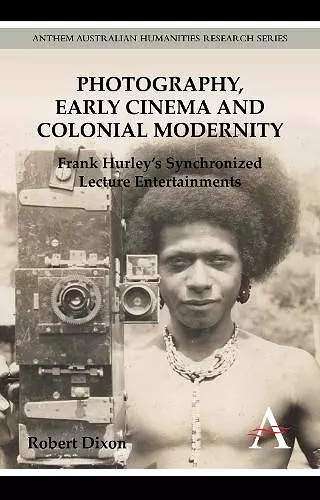Photography, Early Cinema and Colonial Modernity
Frank Hurley's Synchronized Lecture Entertainments
Format:Paperback
Publisher:Anthem Press
Published:1st Nov '13
Currently unavailable, our supplier has not provided us a restock date
This paperback is available in another edition too:
- Hardback£70.00(9780857287953)

An account of Australian photographer and film maker Frank Hurley’s stage and screen practice in the context of early twentieth-century mass media.
This volume is an account of the stage and screen practice of Australian photographer and film maker Frank Hurley, in the context of early twentieth-century mass media.
‘Photography, Early Cinema and Colonial Modernity’ is not a biography of Frank Hurley the man; it is instead an examination of the social life of the many marvellous and meaningful things he made as a professional photographer and film maker. The focus of this volume surrounds the media events that encompassed these various creations – what Hurley called his ‘synchronized lecture entertainments’. These media events were at once national and international; they involved Hurley in an entire culture industry that was constantly in movement along global lines of travel and communication. This raises complex questions both about the authorship of Hurley’s photographic and filmic texts – which were often produced and presented by other people – and about their ontology, as they were often in a state of reassemblage in response to changing market opportunities. This unique study re-imagines, from inside the quiet and stillness of the archive, the prior social life enjoyed by Hurley’s creations amidst the complicated topography of the early twentieth century’s rapidly internationalizing mass-media landscape. As a way to conceive of that space, and of the social life of the people and things within it, this study uses the concept of ‘colonial modernity’.
‘[O]ffers a new way of looking at aspects of Australia’s national culture history and its place in a broader Empire history [and] offers enormous insights into the work of one of the world’s most idiosyncratic figures in what was already a constantly evolving international entertainment industry. […] Dixon’s book is rich in detail and is beautifully assembled, with many telling images.’ —Andrew Pike, ‘Visual Anthropology’
‘This book offers much more than a compelling study of the genius of Frank Hurley. Importantly, it presents a fascinating examination of the inter-relationship of colonial modernity, the cinema and new forms of mass entertainment. A must for anyone interested in the history of the early twentieth century’s mass media and its relationship to everyday life then and now.’ —Professor Barbara Creed, University of Melbourne
‘In clear and erudite prose, Dixon skilfully demonstrates how Hurley’s “synchronized lecture entertainments” operated within the complex web of colonial modernity in the twentieth century. His approach reenergises Frank Hurley’s history and brings significant new performance-based methodologies to the study of colonial Australian photography and early cinema. “Photography, Early Cinema and Colonial Modernity” is a consummate demonstration of the complex web of modernity, traced through exhaustive empirical research, and makes a valuable contribution to the fields of cultural studies, early cinema, and photographic history.’ —Prue Ahrens, ‘Journal of Australian Studies’
‘This volume opens up a rich and original area of scholarship, demonstrating the diverse ways in which new technologies were exploited, but also showing how these new technologies were formed and adapted by their users. Robert Dixon challenges the orthodoxy of the last 30 years of colonial and postcolonial studies by placing Australian multimedia work at the centre of international movements of modernity.’ —Professor Katherine Newey, University of Birmingham
‘In this important and entertaining book Robert Dixon reconstructs the visual culture of the early decades of the twentieth century, when the multi-media travelogue constituted one of the main forms of middle-class international amusement. Dixon explores Hurley’s work not in conventional biographical terms but rather through the social life of “the many and marvellous things he made: negatives, photographic prints, lantern slides, stereographs, films, diaries and newspaper articles that once enjoyed a very active life of their own” (xxi), and the insight they provide into Australia's engagement with the romance and wonder of international modernity. By reviving Hurley’s own term, “synchronized lecture entertainments”, Dixon emphasises the performance-centred, fluid dimensions of the multi-media shows orchestrated by the celebrity lecturer, and the promiscuous intertextuality of the new popular culture forms. […] Dixon successfully evokes the exciting, cosmopolitan visual culture of this turbulent period, producing a nuanced, perceptive account that will remain an essential reference for students and researchers in this field.’ —Jane Lydon, ‘Australian Historical Studies’
‘[O]ffers a new way of looking at aspects of Australia’s national culture history and its place in a broader Empire history [and] offers enormous insights into the work of one of the world’s most idiosyncratic figures in what was already a constantly evolving international entertainment industry. […] Dixon’s book is rich in detail and is beautifully assembled, with many telling images.’ —Andrew Pike, ‘Visual Anthropology’
ISBN: 9781783080632
Dimensions: 229mm x 153mm x 26mm
Weight: 454g
288 pages